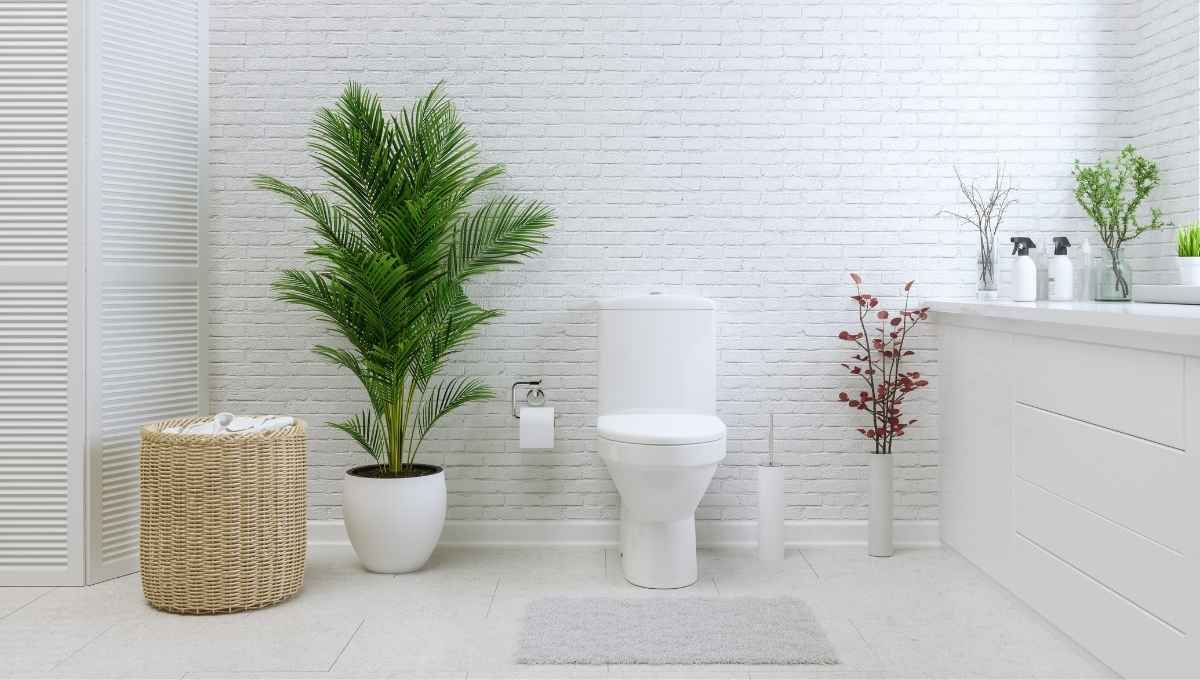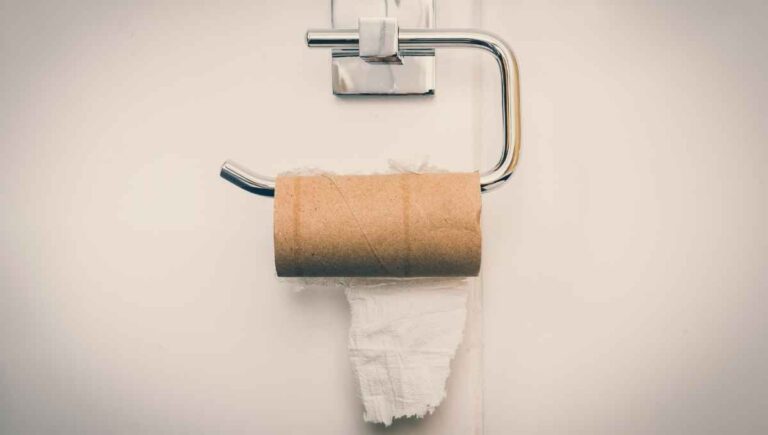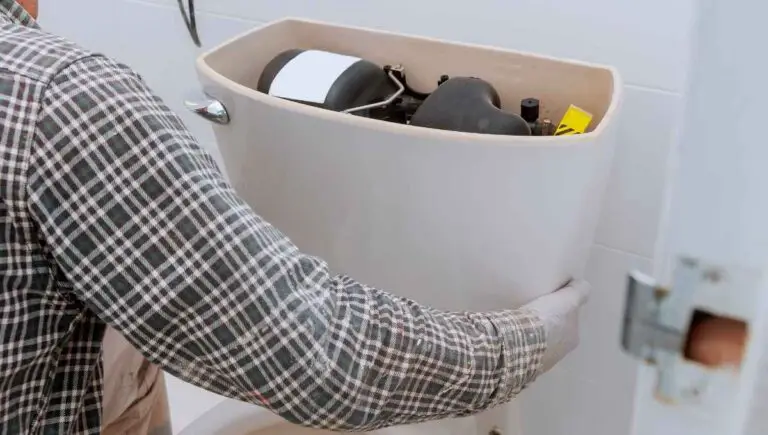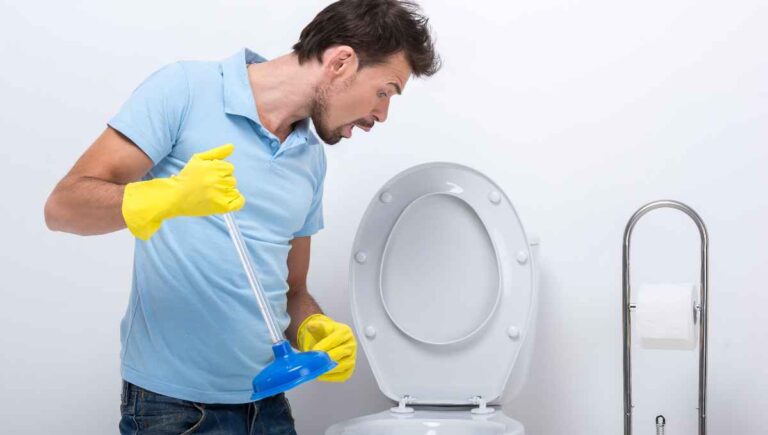How Much Water Does a Toilet Hold? (A Detailed Breakdown)

If you’re trying to save water, one idea you may have is to replace your toilet with a more efficient model. Older model toilets are not good for the environment, whereas newer models are designed to save water. But, how much water does a toilet hold?
Most modern toilets hold an average of four gallons of water. This includes the water in the toilet tank as well as the toilet bowl. Older toilets have been known to hold up to 14 gallons of water. How much water your toilet holds depends largely on your toilet’s make and model.
But, how much water does each section of your toilet hold, and how can you tell how much your toilet holds altogether? Stick with us, and we’ll break the whole thing down for you!
This post contains affiliate links. This means Household Blogger may earn a commission should you make a purchase using any of our links. Please refer to our full affiliate disclosure policy for full details.
Here’s a Quick Pro Tip!
Looking for ways to save money but also keep your toilet in tip-top shape? Try one of these DIY solutions next time you’re struggling with a toilet that’s acting up.
1. Fill Valve – Most toilets start having problems with their fill valve after just a year or two. Replacing it is a quick and easy fix and prevents you from having to replace the whole toilet!
2. Full Tank replacement kit – If the problem is a bit bigger than the fill valve, don’t panic. This kit can help you replace all of your tank innards, so you don’t have to replace the toilet!
3. Screwdriver kit – Just a little extra help to make sure you have the tools you need to do your DIY repairs!
Total Water Held In the Whole Toilet
Before we get into the bigger breakdowns, let’s start by adding up the totals for your average toilet tank. Here we go!
How Much Water Is Usually in a Toilet?
If your toilet is a newer model, it has less than five gallons between what is in the tank and in the bowl. However, if your toilet predates the 1980s, it may hold as many as fourteen gallons total.
Of course, this is just an estimate. Your toilet may hold more or less depending on the make and model.
For example, this high-efficiency Kohler toilet fits the EPA standards for high-efficiency, which is better for the environment, and your wallet, because it uses (and holds) less water than older models.
How Many Gallons Is an Average Toilet Tank?
Your average toilet tank can hold about two gallons of water. This is enough for one flush of your toilet. Because the average toilet flush should only use about 1.6 gallons per flush, there’s no reason your toilet tank should hold more.
Of course, if you have an older model toilet (for example, one that was made before 1980) you may notice that your tank holds, and uses, much more water per flush.
Older model toilets can use up to seven gallons per flush. That’s a lot more than 1.6! Maybe it’s time for an upgrade or getting a replacement toilet tank?
How Much Water Does a Toilet Use per Day?
The average adult uses the restroom at least four times a day, sometimes up to eight. So if each flush uses 1.6 gallons, assuming a family of four adults that uses the bathroom four times a day, your family is using 25.6 gallons a day, just by flushing the toilet.
Of course, if you or someone in your family has health issues, is potty-training, or if your family is larger than four people, your water usage may be even higher.
This is just one reason having a water-efficient toilet is so important.
How Many Gallons Is My Toilet Flush?
If you have a high-efficiency toilet, your using 1.6 gallons of water per flush. If your toilet is an older, lower efficiency model, you may be using up to seven gallons per flush.
Of course, that may not sound like a huge difference at first, but let’s do some math.
If one person uses and flushes a toilet five times a day, with a high-efficiency toilet, they’re using eight gallons of water a day.
If they don’t have a high-efficiency toilet, five flushes a day at seven gallons a flush comes out to 35 gallons a day!
How Much Water Is in an Average Toilet?
The average high-efficiency toilet holds about four gallons of water between the tank and the bowl. This is enough for one flush. Then the tank refills in order to be ready for the next flush.
If you have an older model toilet, you may notice that it has a larger tank and hold more water. You may also notice it runs more.
This is because it needs more water in order to fully complete a flush.
Toilet Tank Measurements
Now that we’ve discussed the toilet as a whole, we will get down into the tank. How much water do you think your tank can hold? Let’s find out!
Is the Toilet Tank Supposed to Be Full of Water?
Your toilet tank should be nearly full of water. This water will be used when you flush to rinse waste down the drain and to refill the toilet bowl. Then, the tank should refill in order to be ready for the next usage.
If you look in your toilet’s tank, you should see that the water is full up until about an inch lower than the highest point of the overflow tubing that runs along the top two-thirds of the tank.
If the water went higher than this, that tube helps prevent overflow by sending that water back into the bowl.
How Much Water Is in the Back of the Toilet?
Your toilet tank holds enough water for one flush. If you have a high-efficiency toilet, this should be around two gallons of water. Of course, if you have an older model toilet, this number may be higher.
When you take the lid off of your toilet’s tank, you should notice that the water fills up approximately two-thirds of the tank.
This is enough to cover one flush of your toilet, but not cause overflow or refilling issues.
Can You Add Water to a Toilet Tank?
If you’re noticing that your toilet is not flushing properly, or if the tank is not completely refilling, you can manually add water, a small amount at a time, to the tank. The water you use should be room temperature.
If you notice that your water is always low, you may need to fix or adjust your floater.
If the floater is missing or broken, you’ll need to get a Universal toilet tank repair kit. These kits have everything you need to repair a damaged floater and more.
How Many Gallons Is the Average Toilet Tank?
If you have a newer model, high-efficiency toilet, the tank holds under two gallons of water. Most hold, at most, 1.6 gallons, the amount used per toilet flush.
While older model toilets may not hold much more than two gallons of water in the tank, they still need more water to complete a flush – they just need to pull more water in while doing it.
This is one reason why older model toilets are more inefficient than the newer models.
You might also enjoy our post on How to Stop Your Toilet Bowl From Refilling
How Do I Know How Many Gallons My Toilet Is?
Your toilet should state somewhere on it how many gallons per flush (often shortened to GPF) it uses. This is the most common form of measurement for a toilet. You will typically find this information stamped under the lid, or on the back or underside of the tank.
If you have an older model toilet, you may be able to find this information on the seat hinge.
If all else fails, you can always call the toilet manufacturer and find out from them directly how many gallons your toilet holds.
Toilet Bowl Measurements
So now that you know how much water is in your tank, what do you think your toilet bowl holds? Let’s see if you were right!
How Many Liters Are in a Toilet Bowl?
Most newer model toilets hold approximately six liters of water per flush. While this number may vary slightly depending on the model of your toilet, it should not be any higher than this.
As long as your toilet fits the EPA standards for a WaterSense toilet, it should not hold more than six liters at a time.
This is better for the environment, and it’s great for your wallet!
Why Is the Water Level in the Toilet Bowl Low?
The water level in your toilet bowl is low because something in the tank isn’t functioning properly. Most of the time, it’s just that the floater needs to be adjusted. You can fix it manually.
Follow these simple steps:
- Find the screw that connects the float to the fill valve.
- Using a screwdriver, twist the screw slowly to adjust the height of the float. If you want more water, turn the screw clockwise to raise the floater.
- Flush your toilet to test.
- If there’s still not enough water, twist the screw further, until the correct amount of water fills the bowl when you perform a test flush.
How Do I Increase the Water Level in My Toilet Bowl?
If you notice that your toilet tank isn’t filling completely, you can always manually add water. Of course, this is inconvenient and not a great long-term solution. You may need to check and adjust your floater, in order to allow more water into the tank.
To adjust the floater:
- Locate the screw on your fill valve that connects to the floater (it looks like a ball that sits on the water in your tank)
- Use the correct screwdriver to slowly twist the screw clockwise (left.) You should see that small floater ball rise slowly as you twist.
- Twist until the floater is in the correct position. You can do this by eye, or your toilet may have a line where the water level should be.
- Once it’s raised to where you want it, do a test flush to ensure your toilet has the correct amount of water.
How Do You Raise the Water Level in a Toilet Bowl?
You can raise the water level in your toilet bowl by adjusting the floater arm in the toilet tank. Raising the arm will allow for more water to fill the tank, leaving more water in the bowl when flushed.
If you’ve tried adjusting the arm, you may need more help to get your water levels back where they should be.
Another option is to get yourself a toilet tank repair kit and use that to replace the floater arm entirely.
How to Adjust the Water in a Toilet Bowl?
The fastest and easiest way to adjust the water in your toilet bowl is to adjust how much water comes into the toilet tank with each flush. To adjust that, you’ll need to move your floater up or down, as the floater determines how much water should be in the tank.
To adjust the floater arm:
- Start by locating the floater arm and its connecting pipe.
- Locate the screw that connects the arm to the pipe.
- Using your favorite screwdriver, twist the screw. Twisting the screw clockwise should raise the arm, allowing more water into the tank. Twisting it counterclockwise will lower the arm and lessen the amount of water allowed into the tank.
- Once you’ve adjusted the floater, simply flush the toilet to test how much water stays in the bowl. You may need to adjust the floater more than once to ensure optimal water amounts.
How Much Water Should Be in the Toilet Bowl After Flushing?
After you have flushed a toilet and allowed the water to pool back in the tank, you should see the water sitting about an inch lower than the overflow hole in your toilet bowl. This water facilitates the next flush.
If your water line is significantly lower, you won’t have enough to properly flush. If it’s too high, it will drain from the overflow pipe and wastewater.
If your floater arm isn’t functioning properly, you may need a repair kit.
How Does Water Stay in a Toilet Bowl?
A small amount of water always remains in your toilet bowl after flushing. This water stoppage is caused by the S-bend in your toilet, and it’s there on purpose! Having that water stops odor, gases, and germs from seeping from the sewer lines and back up your toilet.
If you notice that your water isn’t draining properly, there may be a blockage in the S-pipe. If you don’t want to call a professional to fix it, you can do it yourself.
You’ll just need a toilet snake and a bit of time.
Water Usage/per Flush
So, now you know how much water is in your toilet’s tank and bowl. But, how much water are you flushing every time you use the restroom? I bet you’ll be surprised! Check it out!
How Much Water Does It Take To Flush a Toilet Manually?
If you need to flush a toilet, but your water is disconnected or otherwise inoperable, count on needing at least two gallons. Most high-efficiency toilets need 1.6 gallons to complete a flush.
You can add this water to the toilets tank in order to flush. Simply remove the lid of the toilet tank, and pour room temperature, clean water into the back of the tank.
Make sure the water fills the tank up to the water line before you attempt to flush.
How Many Gallons Is a Standard Flush?
The standard flush from a high-efficient (the only kind allowed) toilet uses 1.6 gallons of water. This is about the amount of water that’s held in your toilet tank. Of course, a small amount of that water will stay in your toilet bowl when the flush completes.
If you have an older, non-standard toilet, they may use up to seven gallons in a standard flush. Yikes! It may be time to upgrade your toilet.
Getting a high-efficiency model is better for your wallet and the environment.
How Many Liters Does a Toilet Flush Use?
A standard, high-efficiency toilet uses approximately six liters of water per toilet flush. This has been the standard amount since the 1990s. If your toilet is older than that, it may use up to 15 liters at a time.
If you have an older model toilet and you want to use less water, consider upgrading to a WaterSense, or other high-efficiency toilets.
Not only are they EPA certified and better for the environment, but they’re also better for your wallet too.
How Much Water Does a Toilet Use per Year?
For one person, who uses and flushes the toilet five times a day, 365 days a year, using an efficient toilet, which uses 1.6 gallons per flush, they will use 2,920 gallons of water a year. If you have a family of four, that means your toilet goes through 11,680 gallons.
And that’s just if your toilet is efficient! If your toilet uses 7 gallons per flush, instead of 1.6, you’ll be looking at one person using 12,775 gallons of water a year, just to flush.
A family of four would use 51,100 gallons. Talk about flushing your money away!
Does a Slow-Filling Toilet Waste Water?
A slow filling toilet can waste some water, as the tank may overflow and drain water through the overflow waste pipe, instead of that usable water running into the bowl where it belongs.
Usually, a slow filling toilet is caused by a clog occurring somewhere between the tank and the bowl, or because the fill valve is broken and will need to be replaced.
You can get both clog remover and a new fill valve from Amazon, and it won’t cost you nearly as much as a plumber visit!
What Happens if a Toilet Runs All Night?
If your toilet runs all night, all it is doing is wasting water. Odds are, your fill valve is either broken or incorrectly assembled. Either way, it is important to fix or replace it as soon as possible to prevent further damage and water loss.
You can buy yourself a new fill valve for under twenty dollars (way less than a plumber would charge!), and it shouldn’t take longer than an hour to install.
This replacement kit comes with everything you need to install it yourself.
Is Flushing the Toilet Wasting Water?
Flushing the toilet every time you use it isn’t overly wasteful, as long as you have a high-efficiency toilet. While flushing the toilet is one of the major sources of water use, it can’t be considered a waste.
Of course, if your toilet isn’t efficient, and it uses seven gallons every time you flush, it is much more wasteful.
Consider replacing your toilet with a more efficient model if your current model was made before the 1990s.
Related Questions
How Much Water Is Used in a Shower?
If you shower for around 8 minutes (the national average for a shower) with a normal water flow, you will use around 17 gallons of water. This will be higher if you take longer showers, and shorter if you’re just taking a quick rinse.
You use approximately 2 gallons per minute when you shower.
If you are concerned that you’re wasting water with your showers, consider getting yourself a High-Efficiency Shower Head, which can be easily installed at home.
What Uses the Most Water in a House?
Typically, a toilet uses the most water in a day in a home, due to its constant use. Other big water uses come from washing machines, hand washing dishes, and showers. Of course, using high-efficiency machines can help keep your water usage down.
Did you know that handwashing dishes actually takes almost double the amount of water, compared to running a load of dishes in your dishwasher?
While getting your dishes clean will cost you some water, it’s wise to use the machine instead.
Is Flushing the Toilet Wasteful?
Flushing the toilet multiple times a day does make your toilet the most water usage heavy object in your home, but it’s really not wasteful. Not flushing can lead to a build-up of bacteria, not to mention bad odors.
Your best bet is to get a high-efficiency toilet so that you’re using less water every time you flush, while still keeping your home sanitary.
All in all, it may seem like you’re flushing away money, but keeping your bathroom clean is worth it.
Final Thoughts
We hope that this article opened your eyes to how much water your toilet can hold, and helped you realize the easy ways you can save water.
It’s easy to misunderstand how much water is used when you flush a toilet, but as long as your toilet is efficient, you’ve got nothing to worry about!












